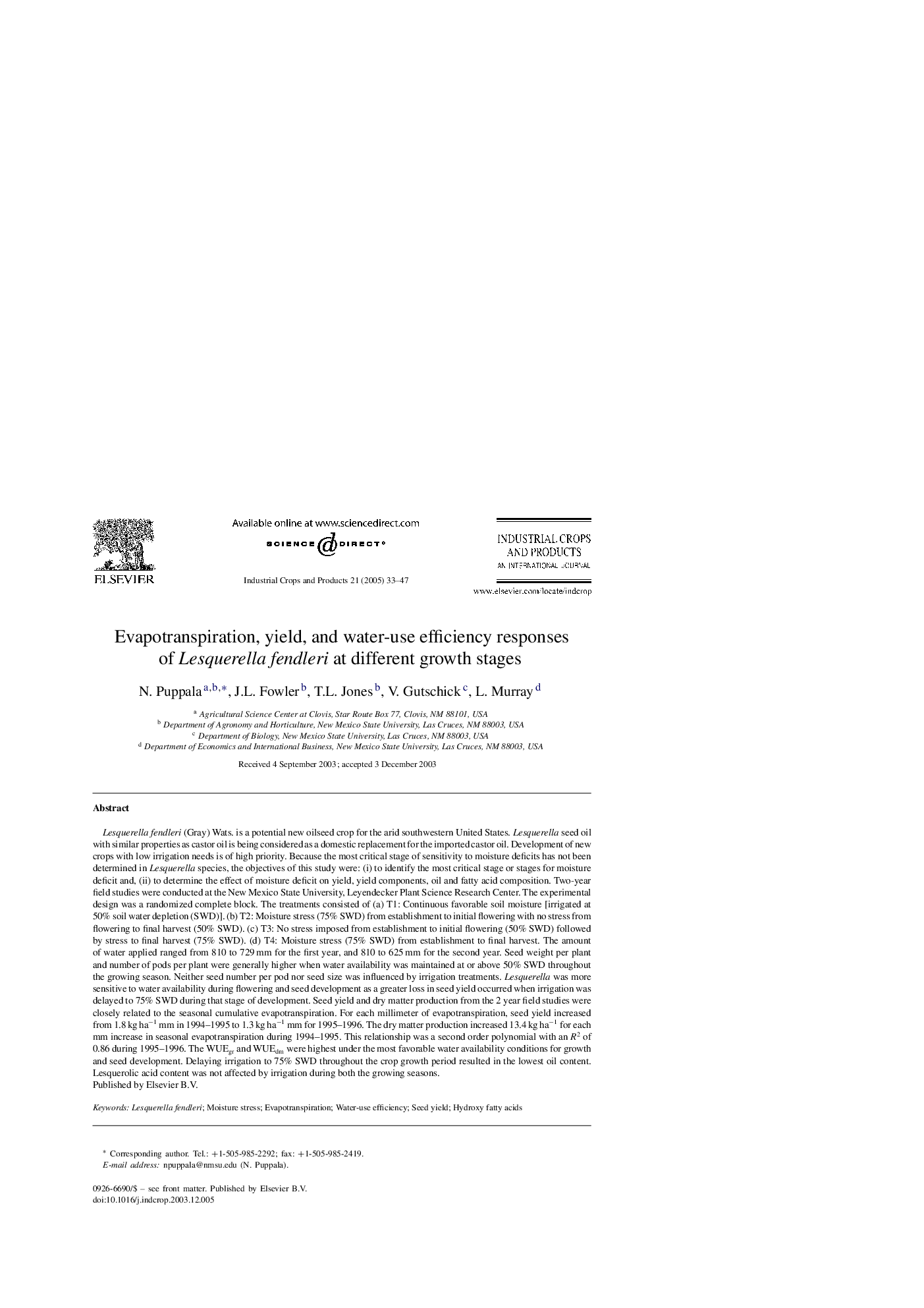| کد مقاله | کد نشریه | سال انتشار | مقاله انگلیسی | نسخه تمام متن |
|---|---|---|---|---|
| 9474167 | 1322249 | 2005 | 15 صفحه PDF | دانلود رایگان |
عنوان انگلیسی مقاله ISI
Evapotranspiration, yield, and water-use efficiency responses of Lesquerella fendleri at different growth stages
دانلود مقاله + سفارش ترجمه
دانلود مقاله ISI انگلیسی
رایگان برای ایرانیان
کلمات کلیدی
موضوعات مرتبط
علوم زیستی و بیوفناوری
علوم کشاورزی و بیولوژیک
علوم زراعت و اصلاح نباتات
پیش نمایش صفحه اول مقاله

چکیده انگلیسی
Lesquerella fendleri (Gray) Wats. is a potential new oilseed crop for the arid southwestern United States. Lesquerella seed oil with similar properties as castor oil is being considered as a domestic replacement for the imported castor oil. Development of new crops with low irrigation needs is of high priority. Because the most critical stage of sensitivity to moisture deficits has not been determined in Lesquerella species, the objectives of this study were: (i) to identify the most critical stage or stages for moisture deficit and, (ii) to determine the effect of moisture deficit on yield, yield components, oil and fatty acid composition. Two-year field studies were conducted at the New Mexico State University, Leyendecker Plant Science Research Center. The experimental design was a randomized complete block. The treatments consisted of (a) T1: Continuous favorable soil moisture [irrigated at 50% soil water depletion (SWD)]. (b) T2: Moisture stress (75% SWD) from establishment to initial flowering with no stress from flowering to final harvest (50% SWD). (c) T3: No stress imposed from establishment to initial flowering (50% SWD) followed by stress to final harvest (75% SWD). (d) T4: Moisture stress (75% SWD) from establishment to final harvest. The amount of water applied ranged from 810 to 729 mm for the first year, and 810 to 625 mm for the second year. Seed weight per plant and number of pods per plant were generally higher when water availability was maintained at or above 50% SWD throughout the growing season. Neither seed number per pod nor seed size was influenced by irrigation treatments. Lesquerella was more sensitive to water availability during flowering and seed development as a greater loss in seed yield occurred when irrigation was delayed to 75% SWD during that stage of development. Seed yield and dry matter production from the 2 year field studies were closely related to the seasonal cumulative evapotranspiration. For each millimeter of evapotranspiration, seed yield increased from 1.8 kg haâ1 mm in 1994-1995 to 1.3 kg haâ1 mm for 1995-1996. The dry matter production increased 13.4 kg haâ1 for each mm increase in seasonal evapotranspiration during 1994-1995. This relationship was a second order polynomial with an R2 of 0.86 during 1995-1996. The WUEgr and WUEdm were highest under the most favorable water availability conditions for growth and seed development. Delaying irrigation to 75% SWD throughout the crop growth period resulted in the lowest oil content. Lesquerolic acid content was not affected by irrigation during both the growing seasons.
ناشر
Database: Elsevier - ScienceDirect (ساینس دایرکت)
Journal: Industrial Crops and Products - Volume 21, Issue 1, January 2005, Pages 33-47
Journal: Industrial Crops and Products - Volume 21, Issue 1, January 2005, Pages 33-47
نویسندگان
N. Puppala, J.L. Fowler, T.L. Jones, V. Gutschick, L. Murray,